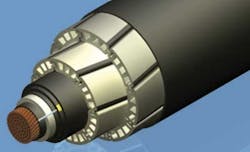Integrated protection system eases DEH cable installations
Technique safeguards integrity in harsh conditions
Audun Haglo
Nexans
Direct Electrical Heating systems (DEH) provide a cost-effective and environmentally friendly form of flow assurance. However, one of the challenges associated with these vital subsea systems is that the power cables need to be protected against mechanical damage, particularly in areas of the world with trawling activities.
The traditional approach to cable protection has been to use external Mechanical Protection Profiles (MPS), assembled by hand, piece by piece, during the installation process. But a new cable design with an integrated protection system (IPS) offers a more cost-effective and efficient method of protecting and installing the DEH piggyback cable.
Long-distance challenge
The trend towards ever deeper waters and longer transportation distances presents a particular challenge for subsea production flowlines, as the combination of high pressures and low seawater temperatures can result in hydrate formation or wax deposits inside the flowline. Such deposits can reduce and even completely block the flow of oil and gas from the template.
(Above) The traditional manually assembled protection system attached during the DEH cable laying process. The yellow pipe is the flowline. The white structure on top is the protected DEH cable. (Below) When the DEH cable is placed into the traditional protection system, it can be a labor- and time-intensive process.
Several methods are employed to prevent the formation of hydrates, with chemical injection still the most widely applied. Over the last decade, however, DEH has emerged as an attractive alternative as it controls the flowline temperature in order to maintain it above the critical threshold for hydrate formation. By heating the flowline electrically the need for chemical injections is reduced considerably. This "cleaner" approach also leads to significantly reduced operating costs, and extends the lifetime of the production well.
With the DEH system, an electric alternating current (AC) in a metallic conductor generates heat. The flowline to be heated serves as an active conductor in the electric circuit, formed by the dynamic DEH Riser Cable (RC), the Armored Feeder Cable (AFC), the Piggyback Cable (PBC), and the flowline.
AC current is supplied from the topside power system via the DEH RC. Subsea, the RC is connected to the AFC in the subsea junction box. Using the AFC, one of the conductors in the DEH riser cable is connected to the flowline near end, while the other conductor is jointed to a PBC. The latter is strapped to the flowline along the entire length to be heated, and connected to the flowline at the far end. The flowline, then becomes the primary return conductor in the system, and is heated due to its own electrical resistance.
For safety and reliability reasons, the flowline is electrically connected to the surrounding seawater (i.e. it is an "open system") through several sacrificial anodes. These aluminum anodes are rated for both corrosion protection and sufficient grounding of the system during the expected lifetime of the flowline and the service life of the heating system. The AC current does not influence the internal corrosion of the flowline.
During operation, power is fed to the far end of the flowline through the PBC and returns through the steel flowline and seawater. At each end of the flowline, where the current enters and leaves the pipe, additional anodes are mounted to form a well-defined, low impedance path for the current to the sea, known as the current transfer zone.
The efficiency of the heating system is highly dependent on the distance between the flowline and the parallel cable (PBC). Increased spacing between the PBC and flowline results in an increased power demand in order to maintain the desired current through the flowline. Therefore, the PBC is strapped to the flowline during installation to ensure as close proximity as possible for the life of the system.
DEH protection
Most DEH systems today have been installed in particularly demanding locations, such as the North Sea where the sea conditions are rough and the weather is severe. Therefore, the power cables in these systems need to be able to cope with harsh seas and low temperatures. In addition, they need to withstand severe mechanical loads, particularly from trawl impacts which are common in the North Sea.
The design of the new DEH cable with integrated protection system.
At the moment the system used to protect the PBC is labor-intensive to install. Typically, as the PBC is unreeled, it is protected with a manually assembled system comprising a plastic profile made up of three individual segments that are attached around the cable to create a continuous protective shield. Each segment is around 2-3 m (6.5-9.8 ft) long and weighs around 15 kg.
The painstaking process of assembling the MPS is often the limiting factor in lay speed for reeling vessels. This problem can be exacerbated when you consider that the length of some pipelines and their associated DEH systems can be upwards of 40 km (24.8 mi).
To address issues associated with the traditional mechanical protection system, the Nexans team developed a new technique that offers sufficient mechanical protection while being more cost effective and much simpler to install.
This new integrated protection system (IPS) is built directly into the piggyback cables by fitting specially designed plastic profiles in the outer layers of the cable during manufacturing. The IPS increases the cable's diameter by approximately 80 mm (3.1-in.), but has no adverse effect on the DEH system's heating capability. For reference, the typical diameter of a PBC without an IPS ranges from 80-100 mm (3.1-3.9-in.). With the IPS, the overall size of the PBC system is significantly smaller than with the traditional external add-on protection.
The IPS is manufactured from a polymer selected for its unique mechanical properties and ability to retain those properties over time in sea water. The reason for choosing a polymer, rather than the more traditional metallic armoring, is because metallic armoring would provide an alternate return conductor for the current, reducing the effect of the system. Had metallic armoring been an option, the protection process would have been relatively straightforward, which is why the innovation associated with the IPS is groundbreaking.
Another key element in the IPS is the design of the internal structure of the profiles. Following extensive computer modeling of mechanical, electrical and thermal properties combined with prototype testing, the ideal design emerged as a series of interlocking segments with hollow cores that are able to absorb high levels of mechanical impact. Another consideration was the need to ensure that the IPS maintained a good level of flexibility for ease of reeling and handling.
The successful elimination of the manually assembled profiles offshore significantly reduces physical handling during installation and of course removes the need to purchase additional protection. The PBC with IPS can be reeled directly off the reel and strapped to the flowline, making the IPS an extremely efficient and cost-effective option.
Protecting Fossekall Dompap's DEH system
In May, Statoil contracted Nexans to design and manufacture a DEH system for subsea pipelines serving the new Fossekall Dompap oil and gas field in 330-360 m (1,082-1,181 ft) in the Norwegian Sea. This field is being tied back to the Norne FPSO, where Nexans previously supplied DEH systems for the Urd and Alve satellite tiebacks.
The contract covers delivery of a complete DEH system, including DEH riser cable with four power cores, armored feeder cables, a 25-km (15.5-mi) piggyback cable and all associated accessories for connection to and installation on the pipeline that will connect the subsea facilities with the Norne FPSO. The piggyback cable incorporates the new Integrated Protection System (IPS).
Statoil plans to start production in December 2012, recovering a total of 63 MMboe, mostly oil. The cables for the Fossekall Dompap DEH system are being manufactured at the Nexans factory in Halden, Norway, for delivery next April.
Offshore Articles Archives
View Oil and Gas Articles on PennEnergy.com


